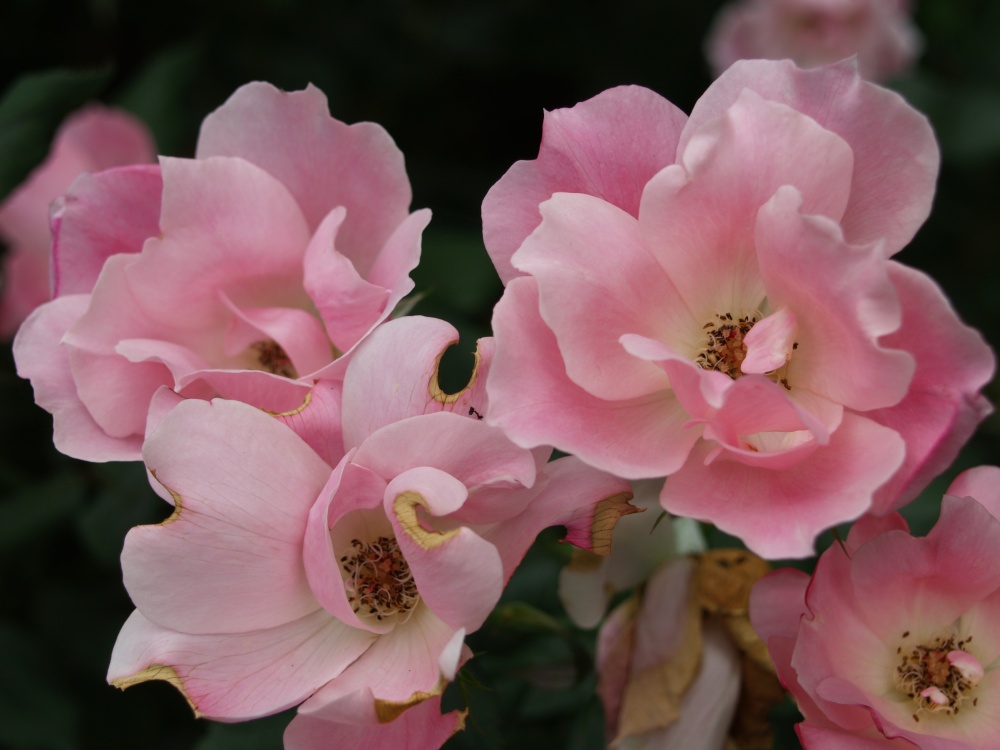Today a cool breeze whistles through the sliver of forest that borders the garden, the tall poplars and maples sway in rhythm. The sun shines brightly, but this is an autumn sun, not the unmerciful sun of summer.
The past week has been quite hot, with temperatures in the mid-nineties that have become so familiar since early in the spring. No rain is forecast in the next week, and after generous rainfall in the first half of August it has turned quite dry. With the turn to cooler temperatures I will not have to be so attentive to watering the new perennials, roses (Rose ‘Oso Easy Paprika’, above), sumac, and loropetalum I planted a week ago.
I don’t expect that we have seen that last of the hot weather, but in September the periods should be shorter, and the humidity more pleasant. It is not surprising to experience a mild frost late in the month (though this is more likely in October), so the gardener can see that the end of summer is near.
I have not been a rose enthusiast, but I planted three disease resistant, low growing varieties for evaluation, and now this has become quite a collection of Knockouts, Drifts, Flower Carpets, Oso Easy, and a few of this’s and that’s (above). Most have survived this horrid summer in fine shape, without black spots, though with fewer blooms. There is very little care involved with any of the roses, and when the Red Flower Carpet roses were diseased a year ago I cut them to the ground in mid-summer rather than spray with a fungicide. This year they rebounded with cleaner foliage, though if this should happen again I’ll chop them from the ground rather than continuing to fight.
Early in the summer the dahlias (above) had grown too tall and were flopping about since I had failed to cut them back at the appropriate time to develop more stocky plants. They were cut in half while in full bloom, and forty-five days later they have reset buds and are flowering again. In a bit longer than a month frost will end their season, and the roots will be dug and stored for next year, but there will be bountiful blooms in September.
The sword-like foliage of Crocosmia ‘Emily McKenzie’ (above) flops over the fading stems of the Asiatic lilies, and it has begun to bloom, more than a month later and with longer lasting flowers than the more common ‘Lucifer’. The earlier, scarlet-red Lucifer has been overwhelmed by neighbors, but Emily McKenzie was given a more favorable location with a bit of space to spread at the edge of the swimming pond.
At times through this difficult summer Corydalis ‘Berry Exciting’ (above) looked quite sad, but with August’s rain it perked up, and the bright gold, lacy foliage and delicate purple blooms light up a spot of deep shade beside a stream leading to one of the garden’s ponds.
Across a stone path, perched at the edge of a pond, but tucked beneath the winding branches of a weeping blue atlas cedar, the Leopard plant (Ligularia dentata ‘Othello’, above) prefers more sun, but has managed quite well with very little. In sunnier spots Leopard plant will often wilt in the afternoon sun, but it does not suffer this problem under the cedar. The bright yellow blooms dependably appear at the start of each September.
There is no more certain sign that September has arrived, and that autumn is approaching, as the abundant, fragrant blooms of sweet autumn clematis (Clematis paniculata, above). This aggressive clematis covers the shaded side of a tall threadbranch cypress, and I had planned to cut it back so that it covered only the wrought iron fence beneath the cypress, but sometimes the simplest of tasks are not accomplished. By some good fortune the cypress has not been smothered, so I will have a second opportunity to assure that the clematis is forced to stay clear of its neighbor.
With cooler temperatures I will be much happier working in the garden, though I am not anxious for frost and falling leaves that loom in another month.